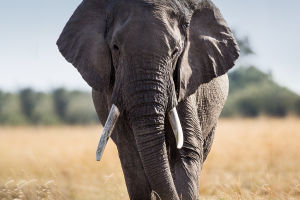Currently, elephants are the largest land animals, mainly represented by African elephants.
Children easily recognize elephants for their unique appearance: long trunks, ears resembling giant fans, thick elephant legs, and so on, all constituting the elephant's distinct features. Many people may not know why elephants have such large ears. Is it merely because of their size?
1. Elephant's ears serve as their "air conditioners."
Elephants inhabit hot regions in Africa and Asia and must regulate their body temperature to prevent overheating.
However, their body surface area relative to their volume is small, making it challenging for them to dissipate heat through the skin. Additionally, they have almost no sweat glands and cannot cool themselves by sweating like humans. So how do they manage?
The answer lies in their ears. Elephants' ears contain many blood vessels. When they flap their ears, it increases blood flow, helping to remove excess heat. It's like a natural fan assisting elephants to stay calm. Elephants can lower their body temperature by about 10 degrees Celsius by flapping their ears.
2. Elephants' ears function as their "communicators."
Besides regulating temperature, the elephant's ears have another crucial function: communication. Elephants are brilliant and social animals with complex languages and behaviors to express their emotions and intentions, one of which involves their ears.
When happy or excited, elephants spread their ears out, indicating friendliness and welcome. When angry or frightened, they raise their ears upright, signaling threat and warning. When elephants want to listen more attentively, they stretch their ears forward, indicating focus and attention. When elephants wish to protect themselves or their companions, they cover their ears against their bodies, showing defense and reassurance.
3. Elephant's ears serve as their "identification cards."
You may have noticed that African and Asian elephant ears are different. African elephant ears are larger and rounder, while Asian elephant ears are smaller and more pointed.
African elephants live in hotter and drier areas, requiring more oversized ears for heat dissipation. Asian elephants, on the other hand, inhabit cooler and moister regions, so they don't need such large ears.
In addition to size and shape, each elephant's ears have unique patterns and marks, reflecting their age and health status. Young elephants typically have pink ears, indicating good blood circulation. Their ears become darker and wrinkled as they age, indicating life experiences. Some elephants have scars and holes in their ears, indicating encounters with danger and challenges.
4. Elephant's ears serve as their "ornaments."
Elephants also use their ears as ornaments. They may coat their ears with mud or sand to alter their appearance and scent. This protects their skin, ward off parasites, and attract mates. Some elephants even decorate their ears with leaves or flowers to enhance their charm and personality.


